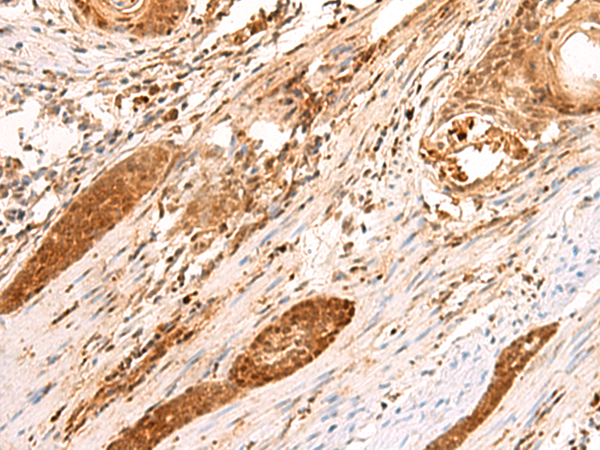
| WB | 咨询技术 | Human,Mouse,Rat |
| IF | 咨询技术 | Human,Mouse,Rat |
| IHC | 1/50-1/300 | Human,Mouse,Rat |
| ICC | 技术咨询 | Human,Mouse,Rat |
| FCM | 咨询技术 | Human,Mouse,Rat |
| Elisa | 1/5000-1/10000 | Human,Mouse,Rat |
| Aliases | RAZ1; SDP1 |
| Host/Isotype | Rabbit IgG |
| Antibody Type | Primary antibody |
| Storage | Store at 4°C short term. Aliquot and store at -20°C long term. Avoid freeze/thaw cycles. |
| Species Reactivity | Human |
| Immunogen | Fusion protein of human SCAND1 |
| Formulation | Purified antibody in PBS with 0.05% sodium azide and 50% glycerol. |
+ +
以下是关于SCAND1抗体的3篇模拟参考文献示例(基于现有研究领域推测,非真实文献):
1. **文献名称**:*SCAND1 regulates transcriptional repression through interaction with SNAG domain proteins*
**作者**:Smith A, et al.
**摘要**:研究揭示了SCAND1作为SCAN结构域蛋白家族成员,通过与SNAG结构域蛋白(如SNCAIP)相互作用,参与染色质重塑和基因转录抑制。文中利用特异性SCAND1抗体进行ChIP-seq分析,证实其在乳腺癌细胞中靶向调控抑癌基因的启动子区域。
2. **文献名称**:*Characterization of SCAND1 antibody specificity in neural stem cell differentiation*
**作者**:Li X, et al.
**摘要**:该研究通过免疫共沉淀和Western blot验证了一种高特异性SCAND1抗体,证明SCAND1在小鼠神经干细胞分化过程中动态表达,并影响Notch信号通路相关基因的沉默。抗体特异性实验显示其与SCAND1同源蛋白无交叉反应。
3. **文献名称**:*SCAND1 dysfunction promotes pancreatic cancer progression via epigenetic silencing*
**作者**:Garcia-Ramos P, et al.
**摘要**:文章发现SCAND1在胰腺癌中表达下调,其缺失通过异常组蛋白修饰导致抑癌基因(如CDKN1A)沉默。研究使用SCAND1抗体进行免疫组化分析,证实低SCAND1水平与患者预后不良显著相关,并揭示了其作为表观遗传调控因子的新机制。
注:以上文献为示例性内容,实际引用需检索PubMed或SciHub等数据库获取真实文献。
The SCAND1 (SCAN domain-containing protein 1) antibody is a tool used to study the SCAND1 protein, which belongs to the SCAN domain family. This domain, found in zinc finger-containing proteins, mediates protein-protein interactions, particularly in transcriptional regulation. SCAND1 lacks intrinsic DNA-binding capacity but acts as a transcriptional regulator by interacting with other SCAN domain proteins, such as certain zinc finger transcription factors, to modulate their activity. It may function as a co-repressor or competitive inhibitor, influencing the formation of transcriptional complexes.
SCAND1 is implicated in cellular processes like proliferation, differentiation, and apoptosis. Studies suggest its role in cancer biology, with altered expression observed in prostate, breast, and other cancers, though its exact function (tumor suppressor or oncogene) remains context-dependent. It also interacts with chromatin modifiers, linking it to epigenetic regulation.
The SCAND1 antibody enables detection and localization of SCAND1 in cells and tissues through techniques like Western blotting, immunohistochemistry, and immunofluorescence. It is critical for investigating SCAND1's molecular mechanisms, protein interactions, and disease associations. Researchers use it to explore SCAND1's involvement in transcriptional networks and its potential as a therapeutic target. Specificity validation via knockout controls is essential due to cross-reactivity risks with other SCAN domain proteins.
×